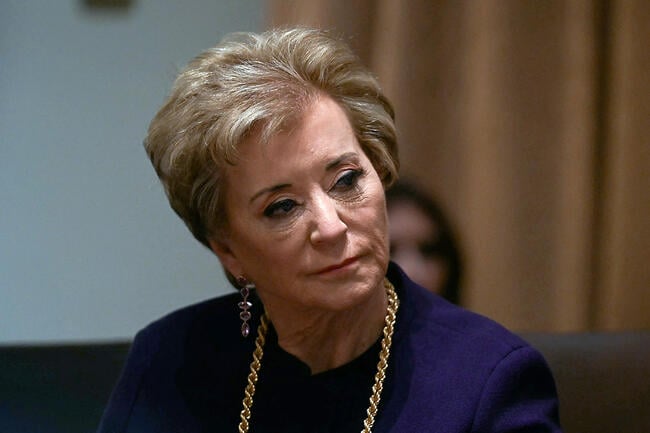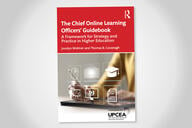You have /5 articles left.
Sign up for a free account or log in.

McMahon says she wants to fix the “broken higher education finance system” as collections resume on defaulted loans.
Jim Watson/AFP/Getty Images
The Department of Education reminded colleges and universities Monday of their role in ensuring student loan borrowers repay their debt—and that they’ll be on the hook if a large percentage of their former students default on their debts.
The guidance to institutions was sent on the same day the department resumed involuntary collections on student loans, which had been on hold since the start of the COVID-19 pandemic in 2020. About 5.3 million borrowers have defaulted on their loans, meaning that they’ve missed at least 270 days of payments, and they could see their federal benefits such as tax refunds or Social Security checks withheld. Another four million borrowers are expected to default in the coming months.
Department officials wrote in the Dear Colleague letter that maintaining healthy federal loan programs “has always been a shared responsibility among student borrowers, the department and participating institutions.” When it comes to the role of colleges, this means transparently disclosing the net cost to students up front and then providing “clear and accurate information” about repayment standards to borrowers throughout their degree program and after graduation.
And though college financial aid offices have long demonstrated a “commitment to providing direct advice and counsel to students,” the letter said, in an era of “critical challenges” for the federal loan system, “institutions must refocus and expand these efforts.”
“For too long, insufficient transparency and accountability structures have allowed U.S. universities to saddle students with enormous debt loads without paying enough attention to whether their own graduates are truly prepared to succeed in the labor market,” Education Secretary Linda McMahon said in a news release. “As we begin to help defaulted borrowers back into repayment, we must also fix a broken higher education finance system that has put upward pressure on tuition rates without ensuring that colleges and universities are delivering a high-value degree to students.”
The department also said Monday that it will calculate for each institution the percentage of borrowers who aren’t paying back their loans and then share that data later this month.
“The department believes that greater transparency is needed regarding institutional success in counseling borrowers and helping them get into good standing on their loans,” officials wrote in the letter.
Student loan payments resumed September 2023, but borrowers who didn’t pay back their loans were shielded from the negative consequences of defaulting. That grace period ended last fall, setting the stage for the restart of collections. The payment and default pause essentially rendered a federal accountability measure known as the cohort default rate meaningless. The rate measures the percentage of borrowers at an institution who have defaulted on their loans over a three-year period, and it hit zero percent in 2023. An institution risks losing access to federal financial aid if its rate hits 30 percent for three consecutive years or 40 percent in one year.
The rate published in 2026 will include borrowers who entered repayment in 2023 and defaulted in 2023, 2024 or 2025, which could mean significant increases to colleges’ default rates.
“As such, we strongly urge all institutions to begin proactive and sustained outreach to former students who are delinquent or in default on their loans to ensure that such institutions will not face high CDRs next year and lose access to federal student aid,” officials wrote in the letter.
The department also directed colleges to remind any borrower who has graduated or stopped out since January 2020 that they must repay any remaining loans that are not in deferment or forbearance and should log in to StudentAid.gov to update their profile, review repayment options and check the standing of their loans. College financial aid offices should reach out by June 30 to students who are behind on payments for one or more of their loans in hopes of preventing defaults, the letter added.




